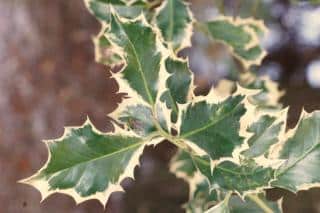

Holly is a shrub that grows in the wild in most areas of the world.
Summary of holly facts
Name – Ilex
Family – Aquifoliaceae
Type – shrub
Height – 6 ½ to 16 feet (2 to 5 meters)
Exposure – full sun, part sun
Soil – ordinary
Foliage: evergreen – Flowering: end of spring – Fruit formation: fall → winter
Holly is famous across the globe for its prickly, pointed leaves and bright red berries.
If holly is found across the planet, it means that it can adapt to all climate types. It can tolerate any type of soil and can survive most natural disasters.

Good to know: Gloves will solve the problem of prickly leaves!
If you are planting in spring, plan for regular watering over the 1st year after planting.
If you’ve only got full sun to plant your holly in, pick cultivars with mottled leaves.
For holly, no pruning is needed, particularly so because holly growth is rather slow.
Nonetheless, you can shape it to your heart’s desire without any problem.
Very famous for its pointed leaves, holly is ornamental and a beautiful decoration.
The berries it produces have different colors depending on the variety, they appear in fall and stay on the tree all winter long. Birds and magpies will enjoy them a lot.
These special berries are what make holly a very ornamental shrub during winter.
The red berries are born by female specimens, and they need to have a male specimen nearby for pollination.
Note that holly berries are poisonous for man.
Holly is a shrub, and can even be considered a tree, but its growth is rather slow.

Ilex altaclerensis – This is a very hardy holly variety, without many thorns. It grows quickly. Its leaves are rimmed with yellow.
Ilex crenata – This holly has no thorns. It produces black berries and is perfect to set up an evergreen hedge.
Ilex latifolia – The berries from this variety are a deep red and its leaves stand out thanks to their great size and shine.
Deck the halls with balls of holly! Its evergreen leaves make it an excellent addition to Christmas ornaments!
The leathery, shiny leaves are beautiful, and don’t break when twisted and handled to prepare decorative ornaments.
Holly is also a sign of good luck when it is hung to the door to form a wreath during the end-of-year rejoicing.
That is why holly slowly became an international Christmas ornament.
To have fruits, you’ll need to plant 2 specimens, one male one and one female one.